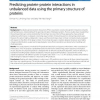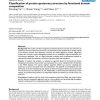262 search results - page 17 / 53 » Protein secondary structure prediction using neural networks |
ISMB
2000
13 years 10 months ago
2000
Knowing the number of residue contacts in a protein is crucial for deriving constraints useful in modeling protein folding, protein structure, and/or scoring remote homology searc...
AI
2005
Springer
13 years 9 months ago
2005
Springer
Abstract. The protein family classification problem, which consists of determining the family memberships of given unknown protein sequences, is very important for a biologist for ...
BMCBI
2010
13 years 4 months ago
2010
Background: Elucidating protein-protein interactions (PPIs) is essential to constructing protein interaction networks and facilitating our understanding of the general principles ...
BMCBI
2006
13 years 9 months ago
2006
Background: The number and the arrangement of subunits that form a protein are referred to as quaternary structure. Quaternary structure is an important protein attribute that is ...
CIKM
2009
Springer
14 years 3 months ago
2009
Springer
Background: Although both conservation and correlated mutation (CM) are important information reflecting the different sorts of context in multiple sequence alignment, most of ali...


